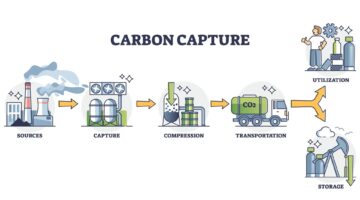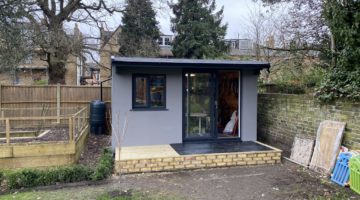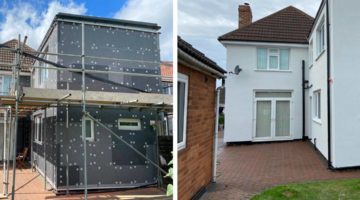
What is solid wall insulation?
If your house was built prior to the 1930s, the chances are that it will have solid walls – simply a solid layer of masonry bricks. Insulating your walls – regardless of whether they are cavity or solid (or even timber-framed) – is a great way to make your home more energy efficient. The insulation will minimise heat loss in the winter, saving you money on your heating bills. It will also stop your home getting too warm in the summer, helping to keep your home at a more comfortable temperature.
According to research, twice as much heat could be lost through an un-insulated solid wall as through an un-insulated cavity wall. However, the great news is that solid walls can be insulated, both internally and externally.
The science behind insulation
If hot air and cold air are partitioned by a wall, heat will transfer through the wall, eventually cooling the room until an equilibrium is reached (where the outside temperature is equal to the inside temperature). In reality this very rarely happens, because rooms tend to be heated; so as heat escapes through the wall, more hot air is supplied by your heating system, keeping it at a comfortable ambient temperature. If the thermal gradient is larger, for example on a cold and wintry day, the movement of the thermal energy across the wall will be accelerated.
Insulating a solid masonry wall helps to provide a thermal barrier, which helps to slow the movement of heat escaping out into the external environment. Less heating is therefore needed to keep the house at the required temperature.
Types of solid wall insulation for your home
Both internal and external insulation are great at keeping your home warmer, lowering your heating bills and cutting carbon emissions. However, both solutions have a different impact on your home, which is explained in the following section:
Internal solid wall insulation
There are a couple of methods to insulate a solid wall internally, which are either to use a rigid insulation board or build a stud wall. We recommend you get a professional in to complete this type of work, and you do not undertake it as DIY unless you are very experienced. Internal solid wall insulation can be as thick as 100mm, so your room will ‘shrink’ wherever it has an external supporting wall.
One way to avoid losing floor space is by using insulating wallpaper, which at only 10mm gives you some benefit of internal solid wall insulation, without impacting on the size of your room. However, the insulating wallpaper will not give you the same performance of dry-lining with the insulation boards unfortunately.
Advantages of internal wall insulation
- Cheaper than external insulation
- No aesthetic change to the outside of your home
- Works well when the home itself is going through a process of internal renovation
Disadvantages of internal wall insulation
- Will reduce the room you have in the living areas by up to 10cm, depending on the materials used
- Won’t necessarily get rid of any damp problems, which need to be tackled separately
External solid wall insulation
For external wall insulation, you need to employ a professional and you also need to consider local building regulations. This is because this process involves covering the original brickwork and could significantly alter the current appearance of the property, making out of step with the local area. Once any planning permission has been granted, the home can be insulated using an adhesive material which is fixed to the wall, then plastered over.
The finish applied to the external wall can be any combination of texturing, painting, tiling, brick slips, masonry work and/or cladding.
Advantages of solid wall insulation
- Less disruption to the household, as the work is carried out outside
- Renews your home’s external appearance and increases the lifetime of the brickwork
- Complements other refurbishment work
- An opportunity to fill cracks and holes in the brickwork, which will help reduce draughts(see Draught Proofing for more information)
Disadvantages of solid wall insulation
- More expensive than internal insulation
- Planning permission may be required
- Any work needs to comply with local building regulation
- May not solve all damp issues
- Work is not recommended if the building is not structurally sound
Costs of solid wall insulation
- Around £100/m2.
- Additional costs for downpipes, gas pipes, boiler flues and dishes.
- Subject to render strength – additional cost to remove old/weak render.
- Potential requirement for scaffolding – around £15/m2.
Measuring the effectiveness of solid wall insulation
The R-value is the measure of thermal resistance used in the building and construction industry today. The higher the R-value, the better the insulating properties of a material – so you should be looking to insulate your house with materials displaying a high R-value. Confusingly, you may hear the word U-value also bandied around. This is exactly the opposite, describing the ability of a material to conduct heat, so you want your insulating material to have a low U-value.
Installing solid wall insulation
Interested in getting solid wall installation? Lucky for you, we work in partnership with EWI Store who specialise in external wall insulation systems! They have a great team who are always happy to help with your enquiries.













Hi am interested in external wall insulation for my house under a grant base system, please advise for survey and possible options.
Hi Salim, if you are based in London, give us a call on 0208 144 0897 and we can talk you through how the process works. If you are based out of London, I suggest finding a local solid wall installer to at least get a quote. The price of getting the works done is approximately £100 / m2, so based on this you should be able to see if the quote provided is fair.
Hello, I have an 1926 detached rendered solid brick house. My heating during the winter is very high also, I have a lot of damp areas… I have only just heard that you can obtain a grant to have this work done. So would value advice and ways of getting the best grant available Thank you
Hi
I live in a 1980’s bungalow in mid wales and it has cavity wall insulation (polystyrene beads) fitted in a 60mm cavity.
There are many cold bridges at each window reveal which causes condensation etc on the wall decoration… the property is quite exposed and the walls are regularly battered by wind and rain in the winter, so I was wondering if it would be advantageous to have external insulation fitted which would vastly improve the cold bridging problems, and make the bungalow walls wind and waterproof and it should help the building interior retain more heat than present.
Is this a suitable solution, or are there any pitfalls with having both cavity and external insulation ?
Your thoughts would be much appreciated
Ray
Hi Ray, Solid wall insulation will protect against water ingress and also provide great thermal efficiency to the wall because you apply a thicker amount (e.g. 10cm of EPS will give u-value of less than 0.3w/m2k) – a cavity in the 1980s would be approx 65mm so the insulation in their won’t be doing as good a job as what could be acheived now (with the EWI) ! Putting solid wall insulation on a pre-filled cavity should be absolutely no problem – and since there is no scaffolding required you are looking at a price of approximately £80 per m2.
I really want to get wall insulation but I am worried that if we do it externally it won’t be sealed. I have read that 25 year warranties get handed out under government schemes but there is no way external silicone is going to last that long. Are there ways to insulate external walls with solid wall insulation without using silicone anywhere l? If so then I would get it in my home
hi can external wall insulation be put on painted brick work
Hi there, it absolutely can. The installer should do a render ‘pull-out test’ to determine how robust the existing facade is. Given that EWI systems are mechanically fixed with supplementary adhesive, it will allow it to be installed on the substrate, whether it is bricked, painted or rendered. A good system designer is EWI Pro – have a look at their website, which should provide more information. But if you need a heads up on good installation companies please also let us know.
In my view the energy savings are more a secondary issue of using an insulated render system like the one talked about in the article above. We had our home insulated under a government green deal scheme, but actually the reason was because the existing render looked awful and so we thought it was time to get it redone. Having been through the process and had the insulation installed, over the past few colder days you can really feel the difference. The house does stay much warmer, but actually for me personally I am just thrilled with the finish that has been acheived. The house is an end terrace so we have three external walls and the existing render had cracked everywhere. The company who installed this new insulated render system took just 10 days and it had completely transformed our home. I would really strongly recommend people to look at doing this especially if you want to escape the dreaded pebble dash finish of the 60s and 70s.
My one piece of advice to those looking to get solid wall insulation on their homes is to research the company that have had it done becuase a few properties on our street did it and the quality of finish is different between different installers so make sure you see some previous examples of their work and ideally speak to these customers!
Hi Sue, we are seeing more and more people who are using solid wall insulation as a means of improving the visual appearance of their homes. While for us, the thermal performance improvement is the main thing, I do appreciate that homes can often look a lot better following the works! Also completly agree with your final comment – finding a good installer is absolutely key – badly installed solid wall insulation can look absolutely awful!
solid wall insulation
Have a house which has a painted tyrolean render finish and need to insulate and render over to achieve correct thermal values
Hi Craig, no problem at all – where abouts in the country are you based?
We have recently had external wall insulation installed primarily to make the property look like new again however this was done on the basis that the internal cavity wall insulation had to be removed this being standard practice for all of the houses in our area choosing to have this done under a government subsidised scheme even though to us there was nothing wrong with the then existing cavity wall insulation having lived in the house for over 20 years.
All that was done was a initial internal inspection to establish if we had cavity wall insulation which was confirmed following which it was removed with no reason being given for its removal + we have never experienced any problems with dampness, lack of warmth etc.
Now that we have the external insulation we feel the house is actually colder than with the cavity wall insulation and we know we are not the only ones as some neighbours have also stated this having had the same work done by the same company handling the project in our area.
I would like to ask therefore, would the overall insulation not have been more effective / efficient if the cavity wall insulation had been left intact as we would then have had a layer from outside to inside made up as follows: Rendering, poly brick, thin air gap, original rendering, brick, cavity insulation, brick, plasterboard as opposed to what we now have being: Rendering, thin air gap, poly brick, original rendering, brick, big cavity air gap previously filled, brick, plasterboard.
My argument is that we now have a layer of cold air between the house bricks fed by the air bricks around the house therefore in effect we only now have one brick and a layer of plasterboard between the inside of the house and the cold outside air which to me is worse than before with the outside insulation having no effect as the air temperature is now balanced between what’s outside and the air gap between the house bricks.
Should not the original cavity wall insulation have been left in place with the external insulation then added which then in effect would have been a much thicker wall between the outside and inside of the house ??????
In addition to this we also had to have a new boiler installed as the exhaust we were told by the company was not up to spec and with work due to start within a few days I had insufficient time to search for a replacement or have one made therefore another contractor was appointed by us who could complete the work in time however this did add considerable cost to the project but perhaps worthwhile as we now burn more gas to heat the house.
require exterior wall insulation
Hi Gary, where abouts are you based?
what grants are available for external wall insulation ?
Hi Margaret, there are still a few councils offering grants under the Green Deal community fund. There is still also partial funding via ECO, although that will only cover about 10 – 20% of the cost of the works.
QUOTE required for external insulation to gable end,
QUOTE required for external insulation to gable end,
Internal insulation MUST have a continuous Vapour barrier or there is high risk of Interstitial condensation in the wall structure or on the face touching the insulation. If the latter then there is high risk the insulation becomes saturated causing untold level of damage.
This is a point often omitted in comments relating to internal insulation.
Interstitial condensation can cause structural damage & dryrot
We have just moved to a bungalow that was built in the 1920s and it’s cold and very damp the external render is cracked all over so we would like to see if we qualify for a green deal grant on it thank you Paul SPAMER
Hi Paul,
There unfortunately is no such thing as a greed deal grant. The green deal is finance mechanism. Some installers do offer some grants via the Eco Scheme though, but you will still need to pay the majority of the cost of the works.
Hi
Are there any grants available for this anymore?
If not, what is the average price you would have to pay
i need to cover 130sqmtrs can you tell me a good price and a name so i can have a chat
Hi Tony, it depends a little bit on the materials – if you go for the industry standard 90mm EPS as the insulation material then you are looking at about £100 per m2. This includes VAT @ 5% because it is an energy saving measure. Obviously prices will vary depending where you are in the country, so you will certainly pay more for it in London than you would say in Glasgow, but it should give you a ballpark figure to do your numbers from
Hello, we live in an old farmhouse in Scotland built in 1800 with 1m granite stone walls. It’s beautiful, but always cold unless heating and fires are on. The external walls are covered with a cement render which is quite course, difficult to keep clean and very difficult to repaint.
We’re looking to renovate over the next few years, starting with understanding our options to insulate and re-render a gable wall which faces the elements. I believe the current render is pulling away and leaking, so this needs to be done first as a matter of priority. But whatever we decide to do now would also be done to the rest of the walls over the coming years. Could you help us find the best way forward ?